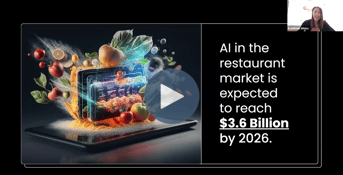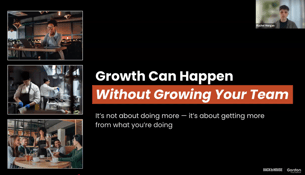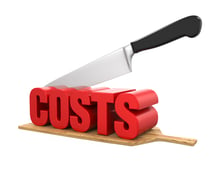Profit margins in the restaurant industry are notoriously thin. Leading POS (point of sale) provider Toast says the average restaurant profit margin is about 3–5%. This doesn’t leave a lot of wiggle room. So it’s easy to see why most restaurant owners say inflation is their biggest pain point right now. The rising cost of food is making it harder than ever for restaurants to turn a profit.
And as our industry grapples with global trade tariffs and supply chain disruptions, the average food cost for restaurant owners is only likely to go up in 2025. So what can we do to preserve our hard-won profit margins, and how can we do it without hurting customer satisfaction?
Fortunately, we’re making incredible leaps in restaurant tech, and with the right solution, you can take steps to weather rising food costs by optimizing your menu, reducing food waste, strategically adjusting prices, and more.
While I can’t tell you that food prices will be coming down anytime soon, I can tell you that these technologies are becoming more accessible and cost effective. With the right combination of tools, you can offset the rising cost of food and keep your profit margins intact.
Why Are Food Costs Rising? Key Factors Impacting the Restaurant Industry
Food costs have steadily risen over the last few years. According to Nerdwallet, food costs spiked 31% between 2019 and 2025. There are several reasons for the rising cost of food.
Higher Operating Costs in Food Production and Transportation
Rising fuel prices trickle down to every step in the supply chain. The price for a gallon of diesel fuel has increased by 22% since 2020, says Nerdwallet. This increases both the cost to operate the farm equipment used in food production and the cost to ship the food from farm to market. It also raises the cost that suppliers charge to restaurants.
Global Supply Chain Disruptions and Inflation
During the COVID-19 pandemic, unpredictable shutdowns, permanent closures, and widespread labor shortages led to major disruptions in the global supply chain. This was followed immediately by record inflation — as high as 9.1% in 2022. It’s dropped since then, but has been inching up steadily since last September. The cost for raw materials and foods has risen across the board.
Five years after the pandemic, the food supply chain remains extremely vulnerable to delay and disruption. International tension and trade wars are having a direct impact on the price and availability of certain foods and ingredients. And these supply chain disruptions threaten to trigger another bout with inflation
Corporate Profits and Shrinkflation
Corporations in the food production industry have responded to the rising cost of food by engaging in a practice commonly referred to as “shrinkflation.” In shrinkflation, food producers reduce portions and food sizes while keeping prices roughly the same, or even increasing them slightly. This means that food producers are cutting into restaurant profit margins to protect their own.
Smart Strategies To Manage Food Costs Without Sacrificing Profitability
Your restaurant’s survival depends on protecting your profit margin. But it also depends on your ability to deliver a great customer experience. The goal is to figure out how to reduce food costs in a restaurant without sacrificing quality. Here are a few ways you can find that balance.
Optimize Your Menu for Higher Margins
One of the most effective ways to manage food costs is by analyzing and optimizing your menu. There are a few ways to do this:
- Identify and promote high-profit menu items that generate more revenue while costing less to produce
- Streamline your menu to draw focus to the most popular or profitable items
- Implement dynamic menu pricing — adjust prices in real time based on
- Demand
- The availability of ingredients
- Fluctuations in the cost of production
The key is to maintain your flexibility. There’s a helpful saying in our business: Manage what you measure. Understand what your costs are, so you know what levers you can pull when needed.
The right restaurant management system (RMS) can help you do exactly that. For instance, MarginEdge uses POS integration and invoice data to show you your food costs in real time, so you can make informed menu pricing decisions in the moment.
Reduce Food Waste to Improve Cost Efficiency
With the rising cost of food, it’s more important than ever to identify the root causes of food waste. An advanced inventory management and waste tracking system can help you identify areas where food is being wasted by spotlighting issues like:
- Overstocking of perishables
- Excess byproduct from food prep techniques
- Oversized servings and portions
Use these findings to streamline your inventory management process, adjust portion sizes, and train kitchen staff to use ingredients more efficiently.
Adjust Pricing Without Losing Customers
Raising menu prices can be a delicate matter. You don’t want to drive your customers away. After all, consumers are feeling the impact of rising food costs too. Still, you do have to adjust your pricing strategically in order to manage these costs.
There are a few ways to strike this balance:
- Gradual price increases can help soften the impact on consumers
- Bundled deals can create the perception of value. For example, you may have to raise the individual menu prices for burgers, appetizers, and beverages, but you can offer a discount rate to customers who purchase a burger, appetizer and beverage together.
- Upselling extras such as additional toppings or sides that were previously free can generate incremental revenue
The key is to avoid increasing all of your prices at once. Find incremental ways to offset your rising expenses without giving your customers sticker shock.
Leverage Technology To Improve Efficiency and Cost Control
Technology can play a significant role in helping you understand, monitor, and manage your food costs. For instance:
- AI-powered inventory management systems can help you view your stock levels in real time. Inventory management software can also help you predict demand for certain ingredients. More accurate inventory forecasting can help you prevent overstocking, which leads to waste and spoilage.
- Digital menus can be managed using mobile devices like smartphones and tablets. This means you can easily adjust menu prices in real time based on customer traffic and demand.
- Self-service kiosks make it possible for your customers to order food on their own using a touchscreen. With an automated ordering system, you can reduce your staffing needs and lower your labor costs.
Whatever technology you adopt to offset the rising cost of food, be sure to keep your focus on the customer experience.
How to Keep Customers Happy While Navigating Rising Costs
There is a good chance that, no matter what steps you take, you will have to raise your menu prices. So how can you do this while still keeping your customers happy? Below are a few tips for protecting customer satisfaction even as the average food cost for restaurant operation goes up.
- Be transparent about the rising cost of food: Use social media to communicate with your customers. Make it clear to your customers that your restaurant is raising prices due to inflation.
- Educate servers on talking points: Train your staff to answer customer questions about rising prices. Focus on value, the quality of your ingredients, and your strong relationships with reputable food sources.
- Use loyalty programs: Give discounts, rewards, or exclusive deals to repeat customers. Give your regulars plenty of reasons to keep coming back even as prices rise.
- Create a memorable experience: Focus on delivering excellent service, great vibes, and a unique menu. Give your customers an experience they can’t get anywhere else.
How Back of House Can Help Your Restaurant Manage Food Costs
Even as food costs continue to rise, the technology you need to manage these food costs is becoming increasingly affordable. From inventory management and waste tracking software to all-in-one POS and RMS platforms, user-friendly tools are available to help you offset rising food costs, preserve your profit margins, and even improve the customer experience.
For a look at some of the technology driving efficiency and improved management in the field, check out our take on the top tech trends in the industry today.





